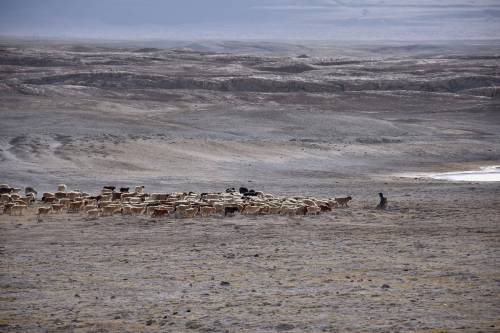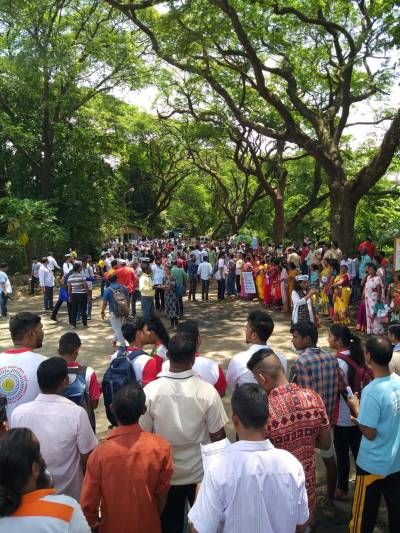Guardians of Life
By Shrishtee Bajpai1)
Guardians of Life
‘Indus has a right to sing,’ said a young girl of Chumathang village in Ladakh, while we sat on the banks of the river Indus (as blue as the sky above), listening to its ruffle caused by strong winds, surrounded by the majestic Trans-Himalayas. We were talking to children about their relationship with water, rivers and river rights. Another child, encouraged by the flow of conversations, said, ‘The river has a right to play.’ ‘Play?’ I wondered, ‘Yes, to play with stones, birds, fishes.’ Having had the conversation on rights of nature with several ‘experts’ who are often caught in the feasibility of the discourse, I wondered what made these children so obviously attuned to them. Amidst all that giggling around the river playing with fish and stones, it was evident that only children living along the rivers could articulate her rights in such an animated way, illustrating their deep connection. For them, ‘rights’ might be an alien framework but the agency of the rest of nature is not.
Early this year, my family immersed my father’s ashes in Ganga (the river Ganges) at Varanasi, believed to be one of the holiest and oldest cities in the world. The priest performing the rituals told us that it is at this moment that the soul is connected to where it came from, becoming part of ‘nature’. Ganga is connected to our birth and death. He sprinkled a few drops of Ganga’s water on all of us, indicating a washing away of all impurities as she, descending from the heavens above, cleanses the entire world. The 13-day rituals performed near the banks of the river are meant to ease the journey of the spirits to other worlds and heal the grieving family. I am not sure if I healed from the loss, but then again the lines between the human and the rest of nature became blurred. Who are we? Ashes? Water? Soil? Or just simply a manifestation of nature in the form of a human body? We are nature and nature is us.
I grew up not very far from Varanasi, in the north Indian city of Kanpur. It is among the most polluted cities in the world and where the mighty and sacred Ganga becomes most poisoned by sewage waste and industrial liquid waste. While I mourned for my father sitting on the banks of Ganga, I also mourned for her. And so, I was taken back to the question: how a sacred river, a goddess and a mother to millions, so integral to daily practices and rituals, is also destroyed and polluted in every conceivable way. Despite the injunctions in dharma2) , we are adrift from our responsibility towards rivers. How do we reflect on this decaying countenance of adharma3).
Having undergone modern education, this question has taken on more of a secular existential threat. How can human civilisations continue to destroy the Earth despite our being dependent on her for our existence? In many ways, this embodied questioning has led me to work with peoples and communities who are defending their waters, territories and ways of being. They are guarding these territories to protect cultures or languages, so that the knowledge of ecological and kinship systems, healing methods, and alternative ways of conceiving the cosmos are not lost.
Are we ready to listen to communities across the world who are already threading a tapestry of possibilities in response to the current crises, and build on these emerging coalitions? But what does it mean to guard? Are we listening to the Earth? How do we tell these stories? How do we bring in the voices of a more-than-human world into modern culture? How do we revive and sustain our relationship with the rest of nature?
During my field work in Korchi in Central India, where the community has been resisting iron ore mining projects for the last two decades, the question of why they are protecting their forests and not taking the jobs offered by mining companies often gets asked. ‘Why do we oppose this mining project, you ask. Let us assume that we adivasis (Indigenous people) will have to leave the forest if the mining company displaces us. But our forest spirits will have no other place to go. Where will so many birds, animals and other species that live in these forests go?’ says Samaru Kallo, a Gond adivasi elder from Korchi in Central India. For Samaru Kallo and his community, the sense of what is a community is not limited to humans alone. In Gondi, there is no word or expression for entitlements or rights, rather their language lays emphasis on duties and responsibilities. The Gonds along with many Indigenous communities in India believe that their sense of responsibility expands to all humans as well as more-than humans. As Izam sai Katengey, another adivasi activist from the region eloquently puts it: Changla Jeevan Jage Mayan Saathi Sapalorukoon Apu Apuna Jababdarita Jaaniv Ata Pahe (to achieve well-being everyone needs to know what their responsibility is). They have actively resisted the destruction of their territories. Alongside resistance, they offer the imaginaries of weaving, healing, and reconstituting the web of life by placing the Earth at its centre.
For the last two years, I, along with colleagues, have been documenting the traditional governance system in Ladakh. While trying to understand how it works in relation to modern governance systems, we realised that peoples’ sense of governance goes much beyond the modern construct. For the Indigenous nomadic communities, the Changpas in Ladakh, their lives are part of a cosmic order where the ‘unnatural’ separation between humans and the rest of nature does not exist.
Herder in Tsokar, Ladakh (photo: Shrishtee Bajpai) ‘We have guardian spirits everywhere. Our pastures, springs, lands, mountains, snow, and animals are all protected by them,’ says Nawang Tharchin, an elder and practitioner of Tantric Buddhism, in the semi-nomadic village Thukjey. ‘Our animals are very important to us, they help us in communicating with the guardian spirits. If our herd is lost, our communication is lost,’ he adds. The lhas and lhus (spirits in the village) protecting the landscapes and humans living in them are a ubiquitous presence. All natural occurrences such as the snowfall in the mountains, and human activities, ranging from agriculture to livestock herding to management of pastures, to birth and death, are to appease the spirits and seek penance for past actions.
‘We have guardian spirits everywhere. Our pastures, springs, lands, mountains, snow, and animals are all protected by them,’ These struggles and articulations assert that we need to pay far greater attention to ‘place’, in knowing our own territories and telling their stories, and in defending and restoring them. I have wondered about my own place in understanding these struggles and standing in solidarity. Why is it important for me to do this?
I am driven by a sense of urgency and by the search for my own sense of place. These worldviews reflect the solidarity that binds all humans and more-than-humans together. These struggles are political and have sacredness, reverence for nature articulated in forms of rituals and prayers. They challenge the replacement of the language of animacy with one that objectifies nature as lifeless and inanimate – possibly the most destructive impact of language imperialism. These worldviews reveal that there is no single definition of well-being or a good life, or as the late deprofessionalised intellectual Gustavo Esteva would say: ‘Our differences shape our existence. Our radical pluralism defines us. We need to build learning coalitions amongst us.’
They show us the possibilities. They show us the pathways. A conviction that we can revive our connection with place and rootedness.
This July in the city of Mumbai (one of the most commercialised and urbanised centres in India) where I am currently based, I was part of a citizen-led protest to protect the rights of forests to exist. The 1,800-acre urban forest called Aarey in the suburbs surrounded by concrete structures, which is home to over 300 species of flora and fauna and to 27 tribal hamlets, is being sanctioned for a Metro-Car shed development.
When I stood with fellow citizens at a peaceful protest against this ecocide, I found my sense of rootedness and understood why it feels essential to work towards what binds us together. Protecting our landscapes – forests, rivers, wetlands, their dependent communities and rights to exist – is our responsibility as humans to our place on Earth. To honour cooperation rather than competition, to resist the rational, mechanistic, extractive and utilitarian Western cognitive empire, and recognise the natural world as persons, spirits and deities with an agency of their own, helps us to transcend the excesses of the Anthropocene and offers pathways for the future.
Living in a city, surrounded by more concrete than nature, I try to remind myself to pause and look around; to pay attention to these remaining urban forests, lakes and rivers; to the plants on my balcony; to the trees changing colours; the starlings that are swirling in the winter sky or the flamingoes that flock to the mudflats after their long journey, and to know who and what sustains them. Honouring the more-than-human world around us, looking with wonder, remembering our inter-dependence, listening to the communities who are struggling and protecting the living world, and helping their voices to be heard in the corridors of power could be our small beginnings to becoming guardians of life.
This piece of writing was initially made available to the public through the Dark Mountain Project. https://dark-mountain.net/the-guardians-of-life/

